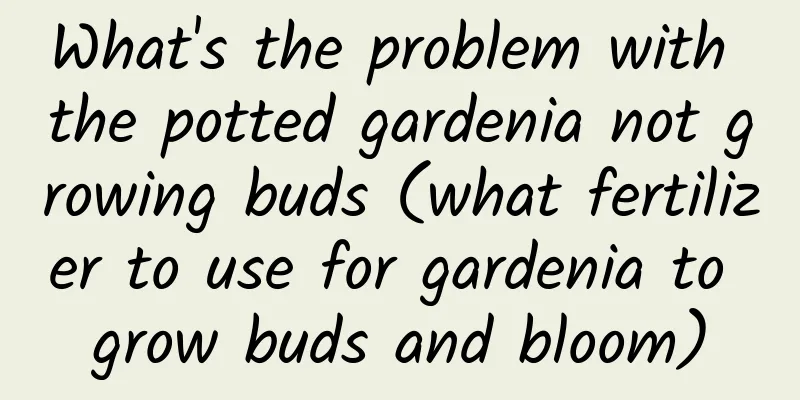What's the problem with the potted gardenia not growing buds (what fertilizer to use for gardenia to grow buds and bloom)

First, the soil causes the lack of flower budsThe soil for gardenia should be loose and breathable, without water accumulation or compaction, and should be slightly acidic and lightly fertilized. (1) Without loose and breathable planting materials, the roots of gardenias cannot breathe well and cannot grow healthily. Without sufficient ability to absorb nutrients, the gardenia plants will be weak and unable to bloom. (2) The drainage of the planting material allows for more flexible watering schedules. If there is even a slight accumulation of water in the soil, causing root rot, or a lack of water, causing the roots to wither, the gardenia will become weak during its recovery period and fail to bloom. (3) Gardenia prefers slightly acidic soil and iron. Iron in alkaline soil will be reacted, and iron deficiency will cause yellow leaf disease. The root system of gardenia cannot adapt to cheap alkaline planting materials. Similarly, the plant is weak and does not bloom. ProcessingThe planting material for gardenia can be mixed soil, which is a mixture of garden soil, humus soil and volcanic rock in a ratio of one third each. This can meet the growth characteristics of gardenia. When watering daily, use "fermented rice water" 2 to 3 times a month to increase the acidity of the soil. Second, environmental reasonsGardenia likes a warm and humid environment. The suitable growth temperature is between 18 and 32 degrees Celsius, and the air humidity is required to reach more than 55%. A suitable growth environment is the prerequisite for the healthy growth of gardenia. If you want gardenia to bloom more, you need to pay attention to the light. Gardenia grows well in a semi-shaded environment. However, to bloom more, it needs to be exposed to more than 6 hours of light per day. TreatmentKeep the gardenia in a balcony that is open from north to south. Keep the gardenia in a full-sun position during daily maintenance. In the summer, the temperature is high and the sunlight is given for 6 hours a day. If there is strong sunlight at noon, we can use a shade net to filter the strong light. Spray the branches with a spray every day to replenish water and humidify the microenvironment. Adequate sunlight is an important part of the flowering of gardenia. Third, apply fertilizer appropriatelyFertilization is divided into different stages and different fertilization methods are given: (1) Use solid organic fertilizer for daily fertilization . Bury the fermented sheep dung balls shallowly into the shallow surface of the flower soil by loosening the soil. Sheep dung balls are mild in nature and have a long-lasting fertilizer effect. They can also improve the pH value of the soil. (2) When fertilizing during the growing season, you can add organic fertilizer water once a month by mixing "fermented rice water" with water in a ratio of 1:3, and watering it on the flower soil to increase nutrients and promote the growth of gardenias. (3) Before the flowering period of gardenia, we can use "potassium dihydrogen phosphate" diluted with water 1500 times as foliar fertilizer . Potassium dihydrogen phosphate can promote cell fission, promote photosynthesis, and promote flowering. (4) Gardenias prefer iron and slightly acidic soil. After six months of care, you can use 800 times the concentration of ferrous sulfate to water the soil every month . This can supplement iron to prevent yellow leaf disease and improve the soil, stabilizing it in a slightly acidic state. (5) After pruning the gardenia, fertilize once with urea containing more nitrogen to promote the growth of lateral buds . Then switch to organic fertilizer with balanced nutrients. Gardenias bloom mostly on new branches, so first promote budding and then apply organic fertilizer with balanced nutrients. Fourth, irregular pruning:In the absence of human intervention, when the gardenia reaches its growing season, the original old branches will continue to grow longer and very few side buds will grow. The ability of new branches to bloom is very low. After the gardenia has grown for a period of time, when the old branches grow to about 3 to 5 centimeters, we must top the branches in time. If you let it grow indefinitely, it will become spindly, which consumes nutrients and results in fewer or no flowers. During daily maintenance, every time the gardenia is fertilized, adventitious buds will grow on the branches and base . These buds not only affect the shape, but also consume a lot of nutrients. They should be removed in time. When the crown grows up, there will be inner branches, underarm branches, stuffy branches, cross branches, etc. They should also be pruned frequently to reduce the consumption of nutrients and concentrate nutrients on the retained branches. |
<<: How can a novice grow hydrangea seedlings well (how to grow hydrangeas well at home)
Recommend
Do I need to put water in the baby's breath vase? (The difference between dried flowers and fresh flowers)
1. Whether to release water Baby's breath nee...
What water to use for growing flowers
1. Water selection 1. Rainwater: When watering fl...
The Flower Language and Legend of Elm
Elm Plant Story "Yu" and "Yu"...
What to do if the peace tree grows too tall
1. How to deal with being too tall Generally, if ...
How to Identify Wild Chrysanthemum
1. Stems and leaves The stems of wild chrysanthem...
How to grow Dendrobium nobile so that it blooms
Flowering time of Dendrobium nobile Dendrobium no...
How to care for pomegranate trees?
The flowers and fruits of the pomegranate tree ar...
Cotton Growth Environmental Conditions and Characteristics
Cotton Growth Environmental Conditions and Requir...
How to grow lilies in small pots
1. Lighting The lilies in small pots have just be...
How to deal with the yellowing and drying leaves of the fortune tree
1. Dry the flower soil 1. Reason: The money tree ...
How to sow the star cactus
1. Choice of flower pots When sowing seeds with t...
What to do if you water the tiger plant too much
1. The consequences of excessive watering Althoug...
How to cultivate osmanthus seedlings, pictures of osmanthus seedlings
1. Prepare the soil It likes to grow in loose, we...
How to make hibiscus bloom more and how to care for it during the flowering period
1. How to make more flowers 1. Choose a good pot ...
Cultivation methods and precautions of Gaoyue Rhododendron
1. Breeding methods 1. Growth habits Since this f...









